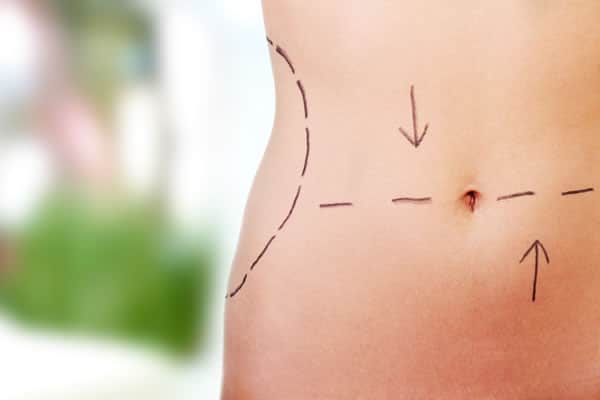L’abdominoplastie : informations pratiques
- TYPE : retirer l’excès de peau et de graisse au niveau du ventre (petit tablier abdominal)
- ANESTHÉSIE : générale
- DURÉE DE L’INTERVENTION : de 2 à 3 heures
- SÉJOUR : ambulatoire ou 24 h
- DÉSOCIALISATION : 5 jours
LES AVANTAGES : Le résultat est spectaculaire et les muscles retendus.

L’abdominoplastie : quand la pratiquer ?
Une paroi abdominale disgracieuse est souvent source de complexes difficiles à supporter. La chirurgie de cette région a été bouleversée depuis l’apparition de la lipoaspiration qui réduit considérablement les cicatrices et les conséquences d’une lourde opération.
Cette intervention n’utilise pas qu’une seule technique pour l’ensemble des cas. Elle nécessite une profonde analyse des lésions et une prise en compte de divers éléments : caractéristiques cutanées, volume de la graisse à retirer, état de la ceinture abdominale, morphologie des patients opérés. Le procédé est alors adapté à chaque cas.
Pour chaque demande de chirurgie de la paroi abdominale, deux possibilités s’offrent aux patients : une lipoaspiration abdominale, pratiquée de manière isolée, ou une plastie abdominale (abdominoplastie).
Si la peau comporte de nombreuses lésions et est très distendue (vergetures, cicatrices), la lipoaspiration seule n’est pas suffisante, une plastie abdominale est alors plus appropriée.
L'abdominoplastie : objectifs et principes
Cette opération a pour but de retirer la peau disgracieuse (distension, vergetures, cicatrices) et de tirer la peau saine alentour.
Pendant cette intervention, on peut également procéder à une lipoaspiration afin de supprimer l’excédent local de graisse et traiter les muscles inférieurs de la ceinture abdominale qui sont abîmés (diastasis, hernie).
La plastie abdominale la plus commune se déroule de la façon suivante : selon un schéma adapté aux lésions, le chirurgien procède à l’ablation d’un fuseau de peau conséquent, comprenant tout ou partie de la zone située entre le nombril et le pubis.
La partie supérieure de la peau qui n’est pas abîmée, située en général au-dessus du nombril, est tirée vers le bas. Ainsi, on obtient une paroi abdominale constituée d’une jolie peau.
La peau abaissée est incisée pour conserver et repositionner normalement le nombril.
Selon l’endroit et la quantité de la peau abîmée où est pratiquée l’ablation, l’intervention laissera une cicatrice résiduelle plus ou moins importante et plus ou moins visible.
En général, cette cicatrice débute au niveau supérieur des poils pubiens et peut s’étendre jusque dans les sillons de l’aine. La longueur de la cicatrice est prévisible et doit être clairement communiquée au patient avant l’opération.
L’assurance-maladie peut, selon les cas et sous certaines conditions, prendre en charge cette intervention.
Une plastie abdominale localisée est parfois envisageable dans le cas de lésions moins importantes. La cicatrice résiduelle sera alors moindre.
Dans ce cas, l’assurance-maladie ne prend pas en charge l’intervention.
L'abdominoplastie : la phase pré-opératoire
Une consultation avec le médecin anesthésiste est prévue au plus tard deux jours avant l’opération.Au préalable, un bilan pré-opératoire est réalisé afin de vérifier qu’aucune contre-indication ne vienne contrarier l’intervention.
- Afin d’éviter tout problème de cicatrisation, il est préconisé de cesser de fumer au minimum un mois avant et un mois après l’opération.
- Dans le cas d’une éventuelle contraception orale, il peut être demandé d’en suspendre la prise afin d’écarter tout risque, surtout en cas de troubles de la circulation sanguine et de coagulation ou d’obésité.
- Il est formellement interdit de prendre des médicaments composés d’aspirine au cours des dix jours précédant l’opération.

L'abdominoplastie : type d'anesthésie et modalités d'hospitalisation et tarifs
- Type d'anesthésie : Une anesthésie générale est quasiment toujours nécessaire pour une plastie abdominale : endormissement pendant toute la durée de l’opération.
- Modalités d'hospitalisation : Un à cinq jours d’hospitalisation sont habituellement requis.

